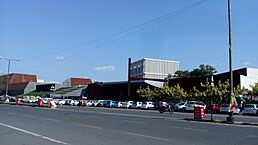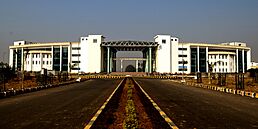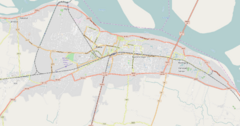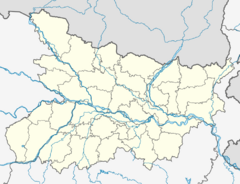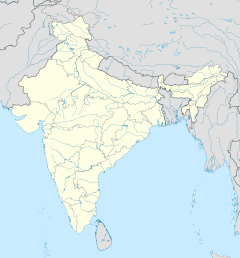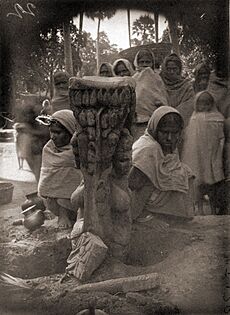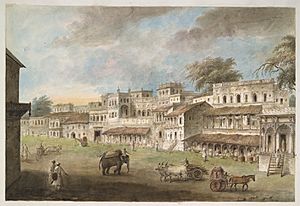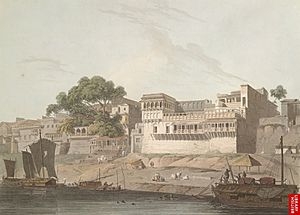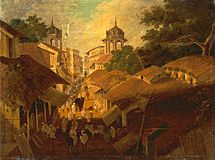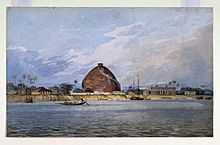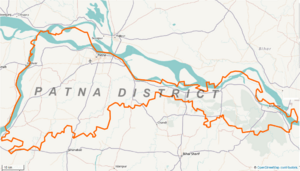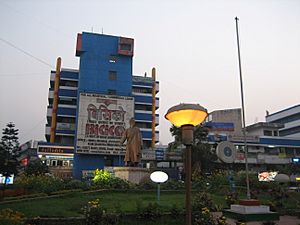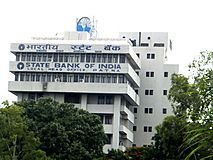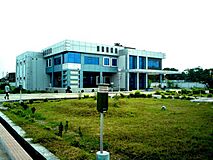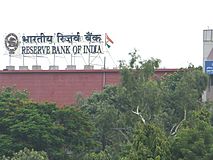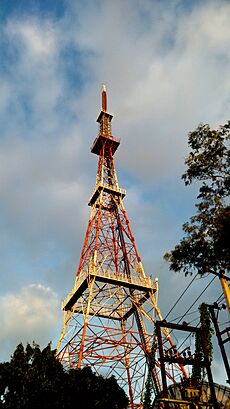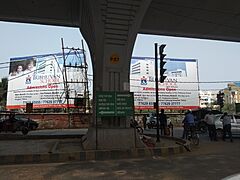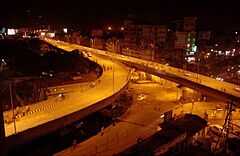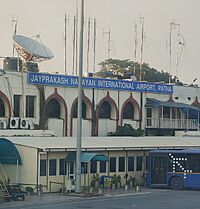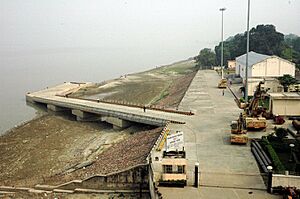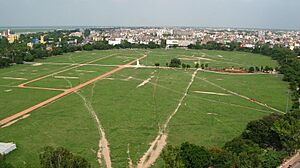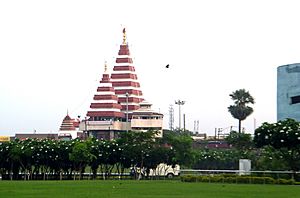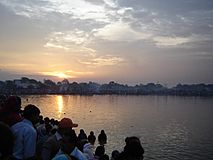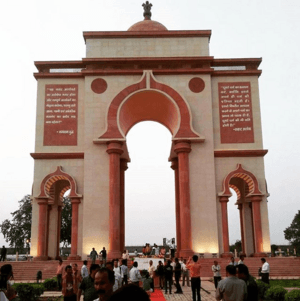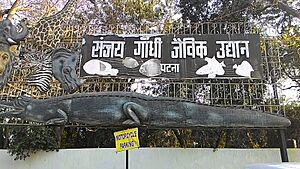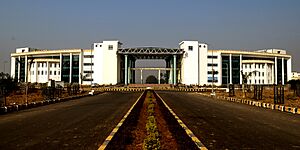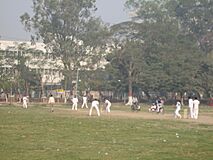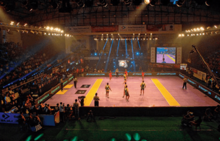Patna facts for kids
Quick facts for kids
Patna
Paṭanā
Pāṭaliputra
|
|
|---|---|
|
Bihar Legislature
Patna High Court
Sabhyata Dwar
Buddha Smriti Park
City view
Mahavir Mandir
Digha–Sonpur Bridge
Bihar Museum in Bailey Road
IIT Patna
|
|
| Country | |
| State | |
| Division | Patna |
| District | Patna |
| Established | 490 BCE |
| Founded by | Udayin |
| Government | |
| • Type | Municipal corporation |
| • Body | Patna Municipal Corporation Nagar Parishad Danapur Nizamat |
| Area | |
| • City | 250 km2 (100 sq mi) |
| • Metro | 600 km2 (200 sq mi) |
| Area rank | 18 |
| Elevation | 53 m (174 ft) |
| Population
(2011)
|
|
| • City | 1,684,222 (IN: 19th) |
| • Density | 6,800/km2 (18,000/sq mi) |
| • Urban | 2,046,652 (IN: 18th) |
| • Metro | 3,874,000 (IN: 12th) |
| Demonym(s) | Pataniya (local), Patnawasi (Hindi), Patnaite |
| Language | |
| • Official | Hindi |
| • Additional official | Urdu |
| • Regional | Magahi Bhojpuri Maithili |
| Time zone | UTC+5:30 (IST) |
| Pincode(s) |
8000xx (Patna)
|
| Area Code(s) | +91-(0)612 |
| ISO 3166 code | IN-BR-PA IN PAT |
| Vehicle registration | BR-01 |
| Literacy (2011) | 82.73% |
| Sex ratio (2011) | 897 ♀/1000 ♂ |
| Airport | Jay Prakash Narayan Airport |
| Rapid Transit | Patna Metro |
| HDI | |
| GDP per capita(2020) | US$7,766 (equivalent to $8,782 in 2022) |
| GDP(2020) | US$17.085 (equivalent to $19.32 in 2022)Billion |
Patna (Hindi: Paṭanā pronounced [ˈpəʈnaː]), also known as Pāṭaliputra in ancient times, is the capital and largest city of the Indian state of Bihar. In 2018, about 2.35 million people lived here, making it one of India's largest cities. Patna covers about 250 square kilometers and is home to over 2.5 million people in its urban area.
Patna is an important city for many religions. Buddhist, Hindu, and Jain holy places like Vaishali, Rajgir, Nalanda, Bodh Gaya, and Pawapuri are nearby. For Sikhs, Patna City is very special because the tenth Sikh Guru, Guru Gobind Singh, was born here. The modern city of Patna is mostly located on the southern bank of the Ganges River. Other rivers like the Son, Gandak, and Punpun also flow near the city.
Patna is one of the oldest continuously inhabited places in the world. It was founded in 490 BCE by the king of Magadha. Ancient Patna, called Pataliputra, was the capital of the Magadha Empire for many powerful dynasties. It was a famous center for learning and arts. Many great thinkers like Aryabhata and Chanakya lived here. During the Maurya period, around 300 BCE, its population was about 400,000.
Patna was a major center of power and culture in the Indian subcontinent during the Mauryan and Gupta empires. After the Gupta Empire fell, Patna lost some of its importance. The British helped it become a major international trade center again in the 17th century. In 1912, after Bengal was divided, Patna became the capital of the Bihar and Orissa Province.
Until the 19th century, Patna was a big trading and business hub in India. After India became independent, its economy stayed strong. Even after Jharkhand became a separate state, Patna's economy continued to grow. In 2011-12, Patna's economy was doing very well, with a high income per person. A study by the City Mayors Foundation ranked Patna as the 21st fastest-growing city in the world and the 5th fastest-growing city in India.
Contents
- Understanding the Name of Patna
- A Look at Patna's Past
- Patna's Location and Environment
- Patna's Economy
- People and Languages of Patna
- How Patna is Governed
- Public Services in Patna
- Getting Around Patna
- Patna's Culture and Traditions
- Places to Visit in Patna
- Learning in Patna
- Sports and Recreation
- Media and News
- Famous People from Patna
- More to Explore
- See also
Understanding the Name of Patna
The name of Patna has changed over a long time. There are a few ideas about where the modern name "Patna" comes from.
Origin of the Name
Many people believe the name "Patna" comes from the word Patan. This is the name of the Hindu goddess, Patan Devi. You can still find Patan Devi Mandir temples in old Patna.
Another idea is that Patna got its name from "Patli," a type of tree that was very common in the old city. This tree is even shown on the state tourism's logo.
Historical Names of the City
Over more than 2,000 years, Patna has been known by many names. Some of these include Pataligrama, Pataliputra, Kusumapura, and Azimabad.
A legend says that the mythological King Putraka created Patna. He made it by magic for his queen, Patali, whose name means "trumpet flower." This gave the city its ancient name, Pataligrama. Later, in honor of the queen's first child, the city was named Pataliputra. Gram means village and Putra means son in Sanskrit.
A Look at Patna's Past
Ancient Times
Stories from Buddhist writings say that Patna was founded around 490 BCE. Ajatashatru, the king of Magadha, wanted to move his capital from the hilly Rajagrha (now Rajgir). He chose a strategic spot on the Ganges River and built defenses there to fight the Licchavis of Vaishali.
Gautama Buddha visited this place in the last year of his life. He predicted that the city would have a great future. He also warned that it might face problems from floods, fires, and conflicts.
The Mauryan Empire Era
Megasthenes, a Greek historian and ambassador, wrote one of the earliest descriptions of Patna. He said the city was located where the Ganges and Son rivers met. He described it as about 9 kilometers long and 1.75 kilometers wide. Megasthenes called it the greatest city on Earth during its peak.
The Shungas ruled Pataliputra for almost 100 years after the Mauryans. Then came the Kanvas and later the Guptas. Chinese travelers, like Fa Hien, visited India to learn. Fa Hien stayed in Pataliputra between 399 and 414 CE to translate Buddhist texts. He noted that the people were rich and kind. Nobles and wealthy families built hospitals where sick and needy people could get free treatment and care.
Gupta and Pala Empires
After the Mauryans, many dynasties ruled from Patna, including the Gupta Empire and the Pala kings. When the Gupta Empire declined, Patna faced difficult times. In the 12th century, Bakhtiar Khilji captured Bihar. He caused much destruction, and Patna lost its importance as a political and cultural center.
Mughal Rule

During the Mughal Empire, Patna was a provincial city. The most notable period was under the Afghan emperor Sher Shah Suri in the mid-16th century. He rebuilt Patna and constructed a fort on the Ganges River. While his fort is gone, the Sher Shah Suri mosque, built in Afghan style, still stands.
Mughal emperor Akbar visited Patna in 1574. His historian, Abul Fazl, wrote that Patna was a thriving center for paper, stone, and glass industries. He also mentioned the high quality of Patna rice, famous in Europe. By 1620, Patna was described as the "chiefest mart towne of all Bengala" for trade. In 1704, Mughal Emperor Aurangzeb allowed his grandson, Prince Muhammad Azim, to rename Patna as Azimabad.
As the Mughal Empire weakened, Patna came under the control of the Nawabs of Bengal. They taxed the people heavily but allowed the city to continue as a trading hub. Guru Gobind Singh, the tenth Guru of the Sikhs, was born in Patna in 1666. His birthplace, Patna Sahib, is a very sacred place for Sikhs.
Portuguese Influence
As trade grew, the Portuguese empire expanded to the Bengal Gulf. By 1580, the Portuguese had set up a trading post in Patna. Goods from Patna were sent down the river to other Portuguese ports and then shipped to other parts of their empire.
British Rule
During the 17th century, Patna became a major international trade center. In 1620, the English East India Company opened a factory in Patna to trade in calico and silk. It soon became important for trading saltpetre. Other European countries like the French, Danes, and Dutch also joined this profitable business.
After the Battle of Buxar in 1764, the East India Company gained the right to collect taxes in this former Mughal province. Patna was fully taken over by the company in 1793. It continued to be a trading center. In 1912, when the Bengal Presidency was divided, Patna became the capital of the British province of Bihar and Orissa.
India's Fight for Freedom
People from Patna played a big part in the Indian independence movement. Important movements like the Champaran movement against indigo farming and the 1942 Quit India Movement happened here. National leaders like Dr. Rajendra Prasad, Anugrah Narayan Sinha, and Jayaprakash Narayan came from Patna.
After Independence
Patna remained the capital of Bihar after India became independent in 1947. Bihar was later divided again in 2000, and Jharkhand became a separate state. In October 2013, there were bombings at an election rally, which caused some deaths and injuries. In October 2014, a crowd surge at Gandhi Maidan during celebrations also led to deaths and injuries.
Patna's Location and Environment
City Layout
Patna is located on the southern bank of the Ganges River. The city covers a total area of about 250 square kilometers. Its average height above sea level is 53 meters. A special feature of Patna's geography is that several major rivers meet nearby. It is the largest city in the world located on a river.
Patna is mostly a flat area with fertile land. The land is almost entirely farmed, and there are no forests. This rich soil is great for growing rice, sugarcane, and other foods. The Mahatma Gandhi Setu, a bridge over the Ganges River, is 5575 meters long. It is one of the longest river bridges in India.
Patna is in India's seismic zone-IV, which means it could be affected by major earthquakes. However, strong earthquakes have not been common recently. The city is also at risk from floods and cyclones.
Weather in Patna
Patna has a humid subtropical climate. This means it has very hot summers from late March to June. The monsoon season brings heavy rains from late June to late September. Winters are chilly with foggy or sunny days from November to February.
The highest temperature ever recorded in Patna was 46.6°C in 1966. The lowest was 1.1°C on January 9, 2013. The most rainfall in a single day was 204.5 mm in 1997.
| Climate data for Patna Airport (1991–2020, extremes 1951–2013) | |||||||||||||
|---|---|---|---|---|---|---|---|---|---|---|---|---|---|
| Month | Jan | Feb | Mar | Apr | May | Jun | Jul | Aug | Sep | Oct | Nov | Dec | Year |
| Record high °C (°F) | 33.1 (91.6) |
35.1 (95.2) |
41.4 (106.5) |
44.6 (112.3) |
45.6 (114.1) |
46.6 (115.9) |
41.6 (106.9) |
39.7 (103.5) |
37.6 (99.7) |
38.2 (100.8) |
34.6 (94.3) |
30.5 (86.9) |
46.6 (115.9) |
| Mean daily maximum °C (°F) | 22.1 (71.8) |
26.1 (79.0) |
32.2 (90.0) |
37.1 (98.8) |
37.5 (99.5) |
36.4 (97.5) |
33.4 (92.1) |
33.1 (91.6) |
32.6 (90.7) |
32.1 (89.8) |
29.1 (84.4) |
24.3 (75.7) |
31.3 (88.3) |
| Mean daily minimum °C (°F) | 9.2 (48.6) |
12.5 (54.5) |
17.0 (62.6) |
22.2 (72.0) |
25.2 (77.4) |
26.7 (80.1) |
26.5 (79.7) |
26.5 (79.7) |
25.7 (78.3) |
22.0 (71.6) |
15.4 (59.7) |
10.7 (51.3) |
20.0 (68.0) |
| Record low °C (°F) | 1.1 (34.0) |
3.4 (38.1) |
8.2 (46.8) |
13.3 (55.9) |
17.7 (63.9) |
19.3 (66.7) |
21.1 (70.0) |
20.2 (68.4) |
19.0 (66.2) |
12.0 (53.6) |
7.7 (45.9) |
2.2 (36.0) |
1.1 (34.0) |
| Average precipitation mm (inches) | 10.2 (0.40) |
12.6 (0.50) |
8.9 (0.35) |
11.9 (0.47) |
48.4 (1.91) |
162.2 (6.39) |
289.1 (11.38) |
266.6 (10.50) |
209.7 (8.26) |
49.7 (1.96) |
5.3 (0.21) |
4.7 (0.19) |
1,077.6 (42.43) |
| Average rainy days | 1.1 | 1.2 | 0.6 | 1.0 | 3.0 | 6.9 | 12.6 | 12.4 | 9.2 | 2.7 | 0.4 | 0.4 | 51.6 |
| Average relative humidity (%) (at 17:30 IST) | 67 | 53 | 38 | 33 | 43 | 59 | 74 | 76 | 76 | 69 | 67 | 72 | 61 |
| Mean monthly sunshine hours | 207.7 | 228.8 | 260.4 | 264.0 | 272.8 | 192.0 | 130.2 | 151.9 | 162.0 | 238.7 | 240.0 | 201.5 | 2,550 |
| Mean daily sunshine hours | 6.7 | 8.1 | 8.4 | 8.8 | 8.8 | 6.4 | 4.2 | 4.9 | 5.4 | 7.7 | 8.0 | 6.5 | 7.0 |
| Average ultraviolet index | 6 | 7 | 9 | 11 | 12 | 12 | 12 | 12 | 11 | 8 | 6 | 5 | 9 |
| Source 1: India Meteorological Department (sun 1971–2000) | |||||||||||||
| Source 2: Weather Atlas | |||||||||||||
Air Quality Concerns
Air pollution is a big issue in Patna. In 2014, a World Health Organization survey said Patna was one of the most air-polluted cities in India. This pollution is mainly from vehicles, factories, and construction.
The air pollution can cause breathing problems like lung cancer and asthma. Thick fog in winter often causes delays for flights and trains. However, in 2024, Patna was ranked as the 10th best "National Clean Air City" in India for cities with over 10 lakh people.
Patna's Economy
Since the 17th century, Patna has been a center for international trade. It was also a hub for farming products and textiles, including silk. After India gained independence in 1947, Patna's economy stayed fairly stable. It saw growth in farming products and vegetable oil manufacturing.
From the 1980s, the economy had some ups and downs. When India opened up its economy in the 1990s, Patna did not attract much global investment. This was a challenge for the city's economy. Many factories, like fertilizer plants and sugar mills, faced problems and had to close.
Since 2005, Patna's economy has been growing steadily. This growth is especially strong in the fast-moving consumer goods industry and the service sector. In 2009, the World Bank ranked Patna as the second-best city in India to start a business. In 2010, Patna was one of the fastest-growing cities in the world and in India.
Patna's main exports are grains, sugarcane, sesame, and a local rice called Patna rice. There are several sugar mills in and around the city. Patna is also becoming an important business and luxury brand center in eastern India.
The main business areas in the city include Bander Bagicha, Exhibition Road, and Gandhi Maidan Marg. Many manufacturing companies, like Hero Cycles and PepsiCo, have factories in the Patna area. Patna is also growing as an information technology hub. For example, Tata Consultancy Services started operations in Patna in 2019.
People and Languages of Patna
In 2011, Patna had about 1.68 million people. This makes it one of the most populated cities in India. If you include the surrounding urban area, the population is over 2 million. People from Patna are sometimes called Patnaites.
Population Details
According to the 2011 census, Patna city had 1,684,222 people. There were more men (893,399) than women (790,823). About 11.32% of the population was under six years old. The overall literacy rate was 83.37%, meaning most people can read and write.
Patna has one of the lowest percentages of people living in slums in India, with only about 0.25% of its population in these areas.
Religions and Languages Spoken
| Religion in Patna city (2011) | ||||
|---|---|---|---|---|
| Religion | Percent | |||
| Hinduism | 86.39% | |||
| Islam | 12.27% | |||
| Christianity | 0.51% | |||
| Other or not stated | 0.83% | |||
Most people in Patna practice Hinduism, making up about 86.39% of residents in 2011. Islam is the second most common religion, followed by about 12.27% of the population. Other religions like Christianity, Jainism, Sikhism, and Buddhism are also present.
Hindi and Urdu are the official languages of Bihar. However, many other languages are spoken in Patna. The local language is Magadhi or Magahi, which comes from the ancient Magadha kingdom. It is believed that Gautama Buddha spoke Magadhi.
In 2011, Hindi was spoken by 65.94% of the population as their first language. Magahi was spoken by 18.04%, Urdu by 9.67%, Bhojpuri by 3.19%, and Maithili by 1.79%.
How Patna is Governed
City Management
The city of Patna is managed by several government groups. The Patna Municipal Corporation (PMC) is in charge of the city's public services. This includes water supply, waste management, street lighting, and building rules.
The PMC has 75 wards, and each ward elects a Councillor. The Mayor leads the PMC. The Municipal Commissioner is the main executive officer and is appointed by the state government. In 2014, the Patna Municipal Corporation was ranked 4th out of 21 cities in India for good governance.
The Bihar Urban Infrastructure Development Corporation Limited (BUIDCO) and the Patna Metropolitan Area Authority plan and develop the wider Patna region. In October 2016, the Bihar cabinet approved the Patna Master Plan 2031. This plan aims to develop a new airport and expand the city's area to make it a larger metropolitan city.
Patna is also one of the hundred Indian cities chosen to become a smart city under a government program. This means it will have modern services like constant electricity, better transport, and improved healthcare. Digital technology will help manage these services.
Public Services in Patna
Patna gets its water from groundwater, managed by Patna Jal Parishad. The city has many tube wells and overhead water tanks for water distribution. The sewerage system in Patna was set up in 1936. New sewerage systems are being built to prevent sewage from flowing into the Ganga River.
The South Bihar Power Distribution Company Limited provides electricity to the city. Patna also has many TV and radio channels. Cable TV and direct-to-home (DTH) services are available.
Patna was the second city in India, after Bangalore, to offer free WiFi to its citizens in February 2014. Patna's free WiFi zone is the world's longest, covering a 20-kilometer stretch.
Getting Around Patna
Road Travel
Major national highways like NH 30 and NH 31 pass through Patna. Important city roads include Ashok Rajpath and Bailey Road. Patna was one of the first places in India to use horse-drawn trams for public transport.
Today, people use buses, auto rickshaws, and local trains to get around. Auto rickshaws are very popular. The Bihar State Road Transport Corporation runs city bus services. App-based taxi services are also available.
Asia's longest river bridge, the Mahatma Gandhi Setu, connects Patna to Hajipur across the Ganga. A new six-lane road bridge, the Kacchi Dargah-Bidupur Bridge, has also been completed. It is the longest bridge in India and connects Patna City to Bidupur.
Air Travel
Lok Nayak Jayaprakash Narayan International Airport is Patna's airport. It is a restricted international airport. More low-cost airlines and new destinations have led to an increase in air travel in recent years. The Airport Authority of India (AAI) plans to build a new airport for Patna at Bihta Air Force Station, about 40 kilometers southwest of the city.
Train Travel
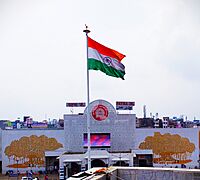
Patna has several railway stations. The Patna Junction railway station is the main one and is very busy. Patna is on the main rail line between New Delhi and Kolkata. The city also has other major stations like Rajendra Nagar Terminal and Patliputra Junction.
India's longest road-cum-rail bridge, the Digha–Sonpur Bridge, crosses the Ganges River. It connects Digha, Patna to Pahleja Ghat in Sonpur. This bridge is 4.55 kilometers long.
Metro System
Patna Metro is a new train system being built for the city. It will have two main lines and will help people travel faster and easier around Patna.
River Transport
The Ganges River has always been an important waterway. In ancient times, large boats carried goods from Pataliputra to the Bay of Bengal. Today, the National Waterway-1, the longest waterway in India, passes through Patna. This waterway helps transport goods along the Ganga River.
Patna's Culture and Traditions
Patna's local language is Magahi, which comes from the ancient Magadhi Prakrit. This was the language spoken in the old kingdom of Magadha. It is believed that Gautama Buddha spoke this language.
Patna has many buildings with beautiful Indo-Islamic and Indo-Saracenic designs. Several old buildings from the British colonial period are now protected as "heritage structures." The Patna Museum, opened in 1917, has large collections of Indian history and art. The Khuda Bakhsh Oriental Library is a historic public library.
Patna has several theaters, including the Bhartiya Nritya Kala Mandir and the Kalidas Rangalaya. The Kalidas Rangalaya hosts the Patliputra Natya Mahotsav, a dance festival.
Patna School of Painting
The Patna School of Painting, also called Patna Qalaam, is a unique art style. It developed in Bihar from the 18th to mid-20th centuries. These painters were descendants of Mughal artists who came to Patna. Unlike Mughal painters who focused on royalty, Patna painters showed everyday life, local people, festivals, and nature scenes. Their paintings were usually watercolors on paper or mica. This art style inspired the College of Arts and Crafts, Patna.
The Bihar Government also promotes Madhubani art to share Bihar's rich culture.
Local Food
Some well-known dishes from Bihari cuisine include sattu paratha (flatbreads stuffed with roasted gram flour) and sattu ka sharbat (a spiced drink). Other popular foods are chokha (spicy mashed potatoes), fish curry, and thekua/khajuria (a type of snack).
Street foods like samosa, chaat, jalebi, and litti chokha are favorites among people in Patna.
Festivals and Celebrations
Traditionally, Bihari women wore cotton saris, but now shalwar kameez and Western clothes are also popular. Men in cities often wear Western clothes, but traditional dhoti and kurta are seen during festivals.
Chhath, also called Dala Chhath, is a major ancient festival in Bihar. It is celebrated twice a year. Durga Puja, held in September–October, is another important festival in Patna with grand celebrations. Other festivals include Saraswati Puja, Eid, Holi, and Christmas.
Cultural events in Patna include the Patna Book Fair, Patna Sahib Mahotsav, and Bihar Diwas. Nearby towns also host festivals like the Rajgir Mahotsav and the Sonepur Cattle Fair.
Places to Visit in Patna
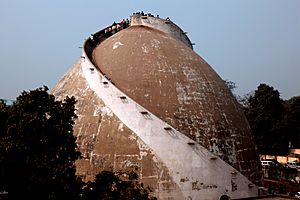
Patna has many interesting places for tourists. In 2005, about 2.4 million tourists visited the city. The cultural history of Bihar can be seen in its many old monuments. Kumhrar and Agam Kuan are sites with ruins from the ancient Pataliputra of Ashoka. The Didarganj Yakshi is a famous example of Mauryan art.
Takht Sri Patna Sahib is one of the Five Takhts (holy seats) of Sikhism. It marks the birthplace of the tenth Sikh Guru, Gobind Singh. There are five other Gurdwaras in Patna connected to different Sikh Gurus.
Buildings like Padri Ki Haveli, High Court, Golghar, and Secretariat Building show examples of British architecture. Gandhi Maidan is a historic ground where many freedom movement rallies took place. The recently built Buddha Smriti Park is also a popular spot.
The Patna Planetarium (Indira Gandhi Planetarium) is said to be one of the largest planetariums in Asia. The Sanjay Gandhi Jaivik Udyan (Patna Zoo) has over 300 mammals, 300 birds, and 450 types of reptiles.
In 2015, the Bihar government built a modern art landmark museum in Patna. It was designed by a Japanese firm and opened to the public. The Sabhyata Dwar, completed in 2018, was built in the Mauryan-style architecture.
Construction of the Samrat Ashok International Convention Centre and the Dr. A.P.J Abdul Kalam Science City also began recently. The Eco Park has over 3,000 types of plants, theme parks, a restaurant, and a boating area.
Learning in Patna
Schools in Patna are either run by the government or are private. They follow different education boards like the Bihar School Examination Board (BSEB) or the Central Board of Secondary Education (CBSE). Hindi and English are the main languages used for teaching.
After ten years of schooling, students can join higher secondary schools. Here, they choose subjects like arts, commerce, or science. After this, they can go for a general degree or a professional degree in fields like law, engineering, or medicine.
Patna has many important government educational institutions. These include Patna University, Indian Institute of Technology Patna, National Institute of Technology, Patna, and Patna Medical College Hospital.
Patna University was started in 1917 and is one of the oldest modern universities in India. Patna also has many other universities and schools.
Nalanda University is a famous university located in Rajgir, about 100 kilometers from Patna. It was started to revive an ancient learning center and attracts students from all over the world.
Sports and Recreation
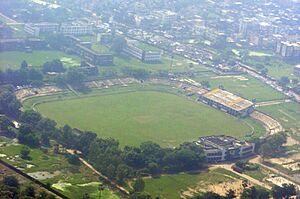
Like in most of India, cricket is very popular in Patna. It is played on grounds and in streets throughout the city. The Bihar Cricket Association manages cricket in Bihar and is based in Patna.
The Moin-ul-Haq Stadium can hold 25,000 people. It has hosted international cricket matches and national sports events. However, due to lack of care, the stadium is not in good condition. A new international cricket stadium is being built in Rajgir.
The Patna Golf Club was founded in 1916 and is one of India's oldest golf courses. It has 18 holes and covers 165 acres.
Patna hosted the first ever Women's Kabaddi World Cup in 2012. India won the World Cup. Patna also hosts matches for the Pro Kabaddi League with its home team, Patna Pirates.
Media and News
At the start of the 20th century, many new publications began in Patna. A monthly magazine called Bharat Ratna started in 1901.
Many national news agencies have offices in Patna, including the Press Trust of India. Major English newspapers like The Hindu, The Times of India, and Hindustan Times have Patna editions. Hindi newspapers like Hindustan Dainik and Dainik Jagran are also published here. There are also Urdu newspapers and a mixed Hindi and English newspaper tabloid called Inext.
Patna has several AM and FM radio stations. These include state-owned channels like All India Radio's Vividh Bharati and FM 105. The All India Radio, Patna, was established in 1948.
Private FM Radio Stations
| No. | Name | Frequency | Language |
|---|---|---|---|
| 01 | Radio Mirchi | 98.3 FM | Hindi |
| 02 | Radio City | 91.1 FM | Hindi |
| 03 | Big FM | 95.0 FM | Hindi & Bhojpuri |
| 04 | Red FM | 93.5 FM | Hindi |
Famous People from Patna
More to Explore
- Patan
- List of cities in Bihar by population
- Patna Lok Sabha constituency
- Largest Indian Cities by GDP
See also
 In Spanish: Patna para niños
In Spanish: Patna para niños









